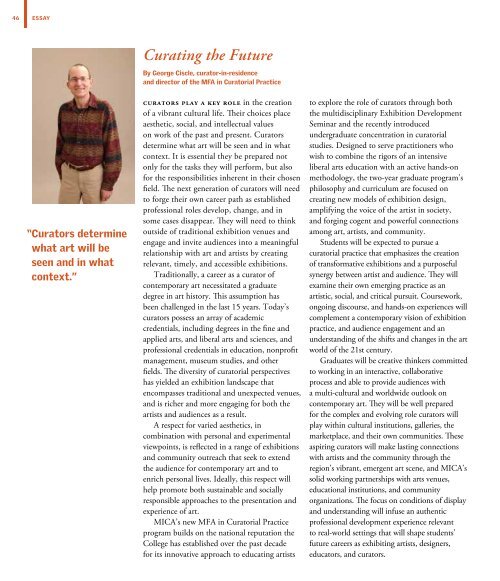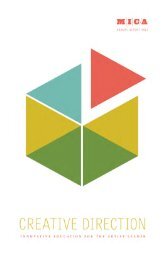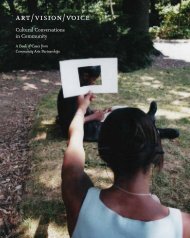Nov.-Dec. 2011 - Maryland Institute College of Art
Nov.-Dec. 2011 - Maryland Institute College of Art
Nov.-Dec. 2011 - Maryland Institute College of Art
You also want an ePaper? Increase the reach of your titles
YUMPU automatically turns print PDFs into web optimized ePapers that Google loves.
46 ESSAY<br />
“ Curators determine<br />
what art will be<br />
seen and in what<br />
context.”<br />
Curating the Future<br />
By George Ciscle, curator-in-residence<br />
and director <strong>of</strong> the MFA in Curatorial Practice<br />
Curators Play a key role in the creation<br />
<strong>of</strong> a vibrant cultural life. Their choices place<br />
aesthetic, social, and intellectual values<br />
on work <strong>of</strong> the past and present. Curators<br />
determine what art will be seen and in what<br />
context. It is essential they be prepared not<br />
only for the tasks they will perform, but also<br />
for the responsibilities inherent in their chosen<br />
field. The next generation <strong>of</strong> curators will need<br />
to forge their own career path as established<br />
pr<strong>of</strong>essional roles develop, change, and in<br />
some cases disappear. They will need to think<br />
outside <strong>of</strong> traditional exhibition venues and<br />
engage and invite audiences into a meaningful<br />
relationship with art and artists by creating<br />
relevant, timely, and accessible exhibitions.<br />
Traditionally, a career as a curator <strong>of</strong><br />
contemporary art necessitated a graduate<br />
degree in art history. This assumption has<br />
been challenged in the last 15 years. Today’s<br />
curators possess an array <strong>of</strong> academic<br />
credentials, including degrees in the fine and<br />
applied arts, and liberal arts and sciences, and<br />
pr<strong>of</strong>essional credentials in education, nonpr<strong>of</strong>it<br />
management, museum studies, and other<br />
fields. The diversity <strong>of</strong> curatorial perspectives<br />
has yielded an exhibition landscape that<br />
encompasses traditional and unexpected venues,<br />
and is richer and more engaging for both the<br />
artists and audiences as a result.<br />
A respect for varied aesthetics, in<br />
combination with personal and experimental<br />
viewpoints, is reflected in a range <strong>of</strong> exhibitions<br />
and community outreach that seek to extend<br />
the audience for contemporary art and to<br />
enrich personal lives. Ideally, this respect will<br />
help promote both sustainable and socially<br />
responsible approaches to the presentation and<br />
experience <strong>of</strong> art.<br />
MICA’s new MFA in Curatorial Practice<br />
program builds on the national reputation the<br />
<strong>College</strong> has established over the past decade<br />
for its innovative approach to educating artists<br />
to explore the role <strong>of</strong> curators through both<br />
the multidisciplinary Exhibition Development<br />
Seminar and the recently introduced<br />
undergraduate concentration in curatorial<br />
studies. Designed to serve practitioners who<br />
wish to combine the rigors <strong>of</strong> an intensive<br />
liberal arts education with an active hands-on<br />
methodology, the two-year graduate program’s<br />
philosophy and curriculum are focused on<br />
creating new models <strong>of</strong> exhibition design,<br />
amplifying the voice <strong>of</strong> the artist in society,<br />
and forging cogent and powerful connections<br />
among art, artists, and community.<br />
Students will be expected to pursue a<br />
curatorial practice that emphasizes the creation<br />
<strong>of</strong> transformative exhibitions and a purposeful<br />
synergy between artist and audience. They will<br />
examine their own emerging practice as an<br />
artistic, social, and critical pursuit. Coursework,<br />
ongoing discourse, and hands-on experiences will<br />
complement a contemporary vision <strong>of</strong> exhibition<br />
practice, and audience engagement and an<br />
understanding <strong>of</strong> the shifts and changes in the art<br />
world <strong>of</strong> the 21st century.<br />
Graduates will be creative thinkers committed<br />
to working in an interactive, collaborative<br />
process and able to provide audiences with<br />
a multi-cultural and worldwide outlook on<br />
contemporary art. They will be well prepared<br />
for the complex and evolving role curators will<br />
play within cultural institutions, galleries, the<br />
marketplace, and their own communities. These<br />
aspiring curators will make lasting connections<br />
with artists and the community through the<br />
region’s vibrant, emergent art scene, and MICA’s<br />
solid working partnerships with arts venues,<br />
educational institutions, and community<br />
organizations. The focus on conditions <strong>of</strong> display<br />
and understanding will infuse an authentic<br />
pr<strong>of</strong>essional development experience relevant<br />
to real-world settings that will shape students’<br />
future careers as exhibiting artists, designers,<br />
educators, and curators.
















